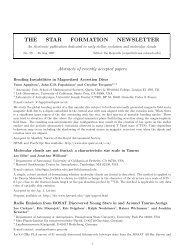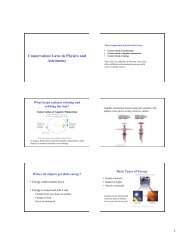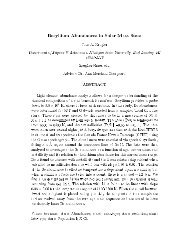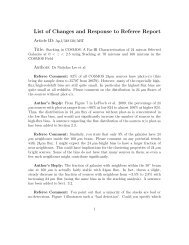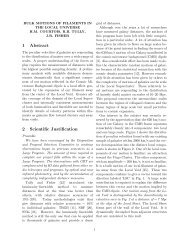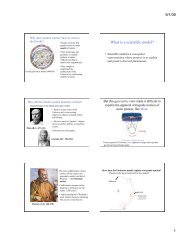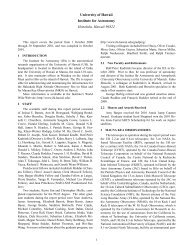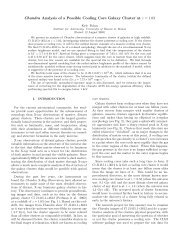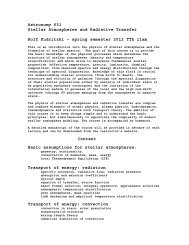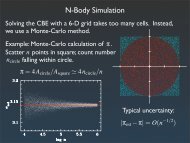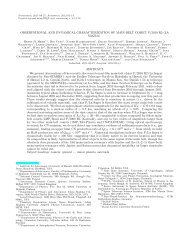Formation of lead/sulfur binary cluster ions by laser ablation
Formation of lead/sulfur binary cluster ions by laser ablation
Formation of lead/sulfur binary cluster ions by laser ablation
You also want an ePaper? Increase the reach of your titles
YUMPU automatically turns print PDFs into web optimized ePapers that Google loves.
International Journal <strong>of</strong> Mass Spectrometry 189 (1999) 147–156<br />
<strong>Formation</strong> <strong>of</strong> <strong>lead</strong>/<strong>sulfur</strong> <strong>binary</strong> <strong>cluster</strong> <strong>ions</strong> <strong>by</strong> <strong>laser</strong> <strong>ablation</strong><br />
Jian-bo Liu, Chun-ying Han, Wei-jun Zheng, Zhen Gao*, Qi-he Zhu<br />
State Key Laboratory <strong>of</strong> Molecular Reaction Dynamics, Institute <strong>of</strong> Chemistry, Chinese Academy <strong>of</strong> Sciences, Beijing 100080,<br />
People’s Republic <strong>of</strong> China<br />
Received 1 November 1998; accepted 14 April 1999<br />
Abstract<br />
Lead/<strong>sulfur</strong> <strong>binary</strong> <strong>cluster</strong> <strong>ions</strong> were produced <strong>by</strong> <strong>laser</strong> single <strong>ablation</strong> and <strong>laser</strong> double <strong>ablation</strong>, respectively, photolyzed<br />
<strong>by</strong> a UV <strong>laser</strong> and detected with a tandem time-<strong>of</strong>-flight (TOF) mass spectrometer. The distribution <strong>of</strong> <strong>cluster</strong> <strong>ions</strong> produced<br />
<strong>by</strong> <strong>laser</strong> single <strong>ablation</strong> is different from that produced <strong>by</strong> <strong>laser</strong> double <strong>ablation</strong>. By <strong>laser</strong> single <strong>ablation</strong> on a mixed Pb S<br />
target, Pb n S <br />
n1 and Pb n S n are formed as stable composit<strong>ions</strong> that serve as structural skeletons <strong>of</strong> the <strong>binary</strong> <strong>cluster</strong>s. All other<br />
<strong>cluster</strong> <strong>ions</strong> can be indicated as Pb n S m with m n 1orPb n S m with m n, produced <strong>by</strong> the attachment <strong>of</strong> excess S atoms<br />
to Pb n S <br />
n1 or Pb n S n . The stable composit<strong>ions</strong> shown above are also found in the fragments from the main photodissociation<br />
channels <strong>of</strong> <strong>cluster</strong> cat<strong>ions</strong>, confirming their special stability. The structural models <strong>of</strong> the <strong>cluster</strong> <strong>ions</strong> with stable composit<strong>ions</strong><br />
are proposed. On the other hand, <strong>by</strong> <strong>laser</strong> double <strong>ablation</strong> on a separated Pb target and S target, the Pb <strong>cluster</strong>s and S <strong>cluster</strong>s<br />
are formed independently and then react with each other to generate <strong>binary</strong> <strong>cluster</strong> <strong>ions</strong> Pb n S m and Pb n S m with n 1–7 and<br />
m 0. These two different formation pathways, <strong>by</strong> <strong>laser</strong> single <strong>ablation</strong> and <strong>laser</strong> double <strong>ablation</strong>, respectively, can <strong>lead</strong> to<br />
distinct differences in the composit<strong>ions</strong> and distribut<strong>ions</strong> <strong>of</strong> the <strong>cluster</strong> <strong>ions</strong>. The different properties, such as internal energies<br />
or structural isomers, for a single stoichiometry from the different formation pathways are also discussed. (Int J Mass Spectrom<br />
189 (1999) 147–156) © 1999 Elsevier Science B.V.<br />
Keywords: Lead/<strong>sulfur</strong> <strong>cluster</strong>s; Laser <strong>ablation</strong>; Time-<strong>of</strong>-flight (TOF) mass spectrometer; Photodissociation<br />
1. Introduction<br />
Lead sulfide compound (PbS) has been well known<br />
as a p-type semiconductor that is <strong>sulfur</strong> rich and an<br />
n-type semiconductor that is <strong>lead</strong> rich [1]. Recently,<br />
the Pb/S <strong>cluster</strong> has drawn much more interest than<br />
bulk PbS and has become the focus <strong>of</strong> semiconductor<br />
<strong>cluster</strong> studies [2,3]. In comparison with bulk PbS, the<br />
Pb/S <strong>cluster</strong> shows a large blue shift <strong>of</strong> the absorption<br />
edge. The bandgap <strong>of</strong> the <strong>cluster</strong> shifts from the<br />
infrared region <strong>of</strong> bulk compound to the visible region<br />
* Corresponding author. E-mail: gaoz@mrdlab.icas.ac.cn<br />
[4], which is quite valuable for electroluminescent<br />
devices such as light-emitting diodes. In addition, the<br />
Pb/S <strong>cluster</strong> is expected to have exceptional thirdorder<br />
nonlinear optical properties [5], and may also be<br />
useful in optical devices such as optical switches.<br />
Pb/S nano<strong>cluster</strong>s have been synthesized in the<br />
condensed phase <strong>by</strong> reaction <strong>of</strong> Pb 2 with H 2 Sinthe<br />
porous matrices such as zeolites [6], ionomers films<br />
[4], and copolymer nanoreactors [7]. The isolated<br />
Pb/S <strong>binary</strong> <strong>cluster</strong>s have also been produced in the<br />
gas phase <strong>by</strong> adiabatic cooling <strong>of</strong> the vapor <strong>of</strong> the PbS<br />
compound [8,9]. By these preparation methods, the<br />
1:1 stoichiometry <strong>of</strong> Pb and S was maintained<br />
1387-3806/99/$20.00 © 1999 Elsevier Science B.V. All rights reserved<br />
PII S1387-3806(99)00068-8
148 J.B. Liu et al./International Journal <strong>of</strong> Mass Spectrometry 189 (1999) 147–156<br />
throughout the <strong>cluster</strong> growth. As a result, the <strong>cluster</strong>s<br />
with stoichiometric composit<strong>ions</strong> like (PbS) n were<br />
mainly produced, whereas the <strong>cluster</strong>s with nonstoichiometric<br />
composit<strong>ions</strong> were difficult to obtain.<br />
However, in view <strong>of</strong> the transition <strong>of</strong> matter from<br />
atoms or molecules to the condensed phase, the<br />
experimental study on Pb/S <strong>binary</strong> <strong>cluster</strong>s with all<br />
possible composit<strong>ions</strong> as well as the nonstoichiometric–stoichiometric<br />
composition transition is a more<br />
important aspect <strong>of</strong> Pb/S <strong>cluster</strong> studies. With this in<br />
mind, we used the technique <strong>of</strong> <strong>laser</strong> <strong>ablation</strong> to<br />
produce Pb/S <strong>binary</strong> <strong>cluster</strong> <strong>ions</strong> in the gas phase. The<br />
<strong>laser</strong> <strong>ablation</strong> with a single <strong>laser</strong> beam can accomplish<br />
the vaporization and ionization <strong>of</strong> the sample, followed<br />
<strong>by</strong> the <strong>cluster</strong>ing process [10]. During the<br />
<strong>laser</strong>-based <strong>cluster</strong>ing process, the produced <strong>cluster</strong>s<br />
are subjected to frequent collis<strong>ions</strong> with each other,<br />
which can <strong>lead</strong> <strong>cluster</strong>s to dissociation and recombination.<br />
The final composit<strong>ions</strong> and distribut<strong>ions</strong> <strong>of</strong> the<br />
<strong>cluster</strong>s can provide more valuable information on the<br />
stability and bonding <strong>of</strong> <strong>cluster</strong>s.<br />
For generation <strong>of</strong> mixed <strong>cluster</strong>s, the samples can<br />
be used in various ways. We have investigated transition<br />
metal/<strong>sulfur</strong> <strong>binary</strong> <strong>cluster</strong>s <strong>by</strong> <strong>laser</strong> single<br />
<strong>ablation</strong> [11–13]. The <strong>laser</strong> single <strong>ablation</strong> only contains<br />
one target made <strong>of</strong> the mixture <strong>of</strong> transition<br />
metal and <strong>sulfur</strong> that is ablated <strong>by</strong> a <strong>laser</strong> beam. Kaya<br />
and co-workers applied <strong>laser</strong> <strong>ablation</strong> on two rotating<br />
targets to generate <strong>binary</strong> <strong>cluster</strong>s [14]. Martin and<br />
co-workers used <strong>laser</strong> <strong>ablation</strong> on one sample and<br />
used an oven to vaporize another sample for the<br />
formation <strong>of</strong> mixed <strong>cluster</strong>s <strong>of</strong> metal and fullerene<br />
[15]. More recently, we developed another <strong>laser</strong><br />
<strong>ablation</strong> technique—<strong>laser</strong> double <strong>ablation</strong> (LDA) to<br />
generate mixed <strong>cluster</strong>s [16]. The <strong>laser</strong> double <strong>ablation</strong><br />
contains two separated targets that are ablated <strong>by</strong><br />
<strong>laser</strong> beam, respectively. Here, we report on the Pb/S<br />
<strong>cluster</strong>s produced from two different sources—the<br />
LSA and the LDA, respectively. The produced <strong>cluster</strong><br />
<strong>ions</strong> were recorded <strong>by</strong> a tandem time-<strong>of</strong>-flight mass<br />
spectrometer (tandem TOF MS). The mass-selected<br />
<strong>cluster</strong> <strong>ions</strong> were further photolyzed and mass analyzed<br />
<strong>by</strong> the secondary stage <strong>of</strong> tandem TOF MS.<br />
Based on these experimental results, the differences in<br />
<strong>cluster</strong> formation in the LSA and LDA are discussed<br />
in this article.<br />
2. Experimental<br />
In the LSA, a well-mixed Pb S sample was<br />
prepared <strong>by</strong> grinding the mixture <strong>of</strong> Pb (99.9%) and<br />
precipitated S (99%) into fine powder, and pressing it<br />
into a tablet with 12 mm diameter and 5 mm thickness<br />
to form the <strong>laser</strong> target. To examine the dependence<br />
<strong>of</strong> <strong>cluster</strong> distribution on the composition <strong>of</strong> solid<br />
sample, the molar ratio for Pb:S in the samples was<br />
varied from 1:1 to 1:8 in the experiments. The sample<br />
target was mounted in the source chamber <strong>of</strong> the<br />
tandem TOF MS, which was evacuated to 10 4 Pa<br />
before <strong>laser</strong> <strong>ablation</strong>. The <strong>laser</strong> <strong>ablation</strong> was carried<br />
out <strong>by</strong> the second harmonic <strong>of</strong> a pulsed Nd:YAG <strong>laser</strong><br />
(532 nm wavelength, 10 ns pulse width, 10 Hz, 10–20<br />
mJ/pulse). The <strong>laser</strong> beam was gently focused with a<br />
lens ( f 50 cm) to a spot <strong>of</strong> 0.5 mm diameter on the<br />
target with a power density on the order <strong>of</strong> 10 7<br />
W/cm 2 . The target surface under <strong>ablation</strong> was vaporized<br />
into a plume in a plasma state consisting <strong>of</strong><br />
electrons, atoms, molecules, and other small species,<br />
either neutral or charged. Complicated react<strong>ions</strong> took<br />
place in the plasma [10], and Pb/S <strong>binary</strong> <strong>cluster</strong>s<br />
were produced therein.<br />
The LDA is conceptually the same technique as the<br />
LSA, with the difference being in the arrangement <strong>of</strong><br />
<strong>laser</strong> targets [16]. As indicated in Fig. 1, two sample<br />
targets, pure Pb and pure S, were arranged in the LDA<br />
instead <strong>of</strong> a single mixed Pb S target in the LSA.<br />
The two targets were placed parallel to each other and<br />
separated <strong>by</strong> a fixed distance, with the S target in<br />
front. A channel <strong>of</strong> 0.5 mm diameter was drilled<br />
throughout the S target, so the <strong>laser</strong> could pass<br />
through the channel and reach the surface <strong>of</strong> the Pb<br />
target. In such a setup, the <strong>laser</strong> can simultaneously<br />
ablate both S and Pb. If the distance between the two<br />
targets is too short, the emitted species from the two<br />
targets meet first and then the mixed <strong>cluster</strong>ing<br />
occurs. This <strong>cluster</strong>ing process is similar to that in the<br />
LSA as discussed above. But if the distance between<br />
targets is long enough for the accomplishment <strong>of</strong>
J.B. Liu et al./International Journal <strong>of</strong> Mass Spectrometry 189 (1999) 147–156<br />
149<br />
Fig. 1. Scheme <strong>of</strong> the LDA.<br />
independent <strong>cluster</strong>ing <strong>of</strong> the emitted species from<br />
each target, then the react<strong>ions</strong> between two kinds <strong>of</strong><br />
<strong>cluster</strong>s can be achieved when some <strong>of</strong> the <strong>cluster</strong>s<br />
from the first target sputter through the channel <strong>of</strong> the<br />
second target. In the latter case, the LDA can be used<br />
to study the react<strong>ions</strong> between <strong>cluster</strong>s. This is, in<br />
fact, the main consideration in the development <strong>of</strong><br />
LDA and the intrinsic feature <strong>of</strong> this setup. Compared<br />
with the Fourier transform ion cyclotron resonance<br />
mass spectrometer [17] and the flow tube reactor [18],<br />
which have been extensively applied in studies on<br />
react<strong>ions</strong> <strong>of</strong> <strong>cluster</strong>s, the LDA is much simpler and<br />
still efficient.<br />
The analysis <strong>of</strong> <strong>cluster</strong> <strong>ions</strong> was conducted <strong>by</strong> the<br />
homemade tandem TOF MS, the details <strong>of</strong> which<br />
were published elsewhere [19]. In brief, the <strong>cluster</strong><br />
<strong>ions</strong> produced <strong>by</strong> <strong>laser</strong> <strong>ablation</strong> were extracted and<br />
accelerated <strong>by</strong> 0.1 kV and 1.1 kV, respectively, and<br />
entered the flight tube. After flying over a 3.5-m-long<br />
field-free flight tube, the <strong>cluster</strong>s with different<br />
masses were separated and detected <strong>by</strong> the dual<br />
microchannel plates. The mass resolution <strong>of</strong> the first<br />
stage <strong>of</strong> tandem TOF MS is about 300. The <strong>cluster</strong><br />
cat<strong>ions</strong> with a specific mass can be picked out <strong>by</strong> a<br />
mass gate at the end <strong>of</strong> the flight tube. The selected<br />
<strong>ions</strong> were then decelerated <strong>by</strong> a retarding field <strong>of</strong> 0.9<br />
kV, and photolyzed <strong>by</strong> an excimer <strong>laser</strong> beam (Lambda<br />
Physik LPX 300, KrF, 248 nm wavelength, 4 ns<br />
pulse width, 10 Hz, 10 mJ/cm 2 ). Following <strong>laser</strong><br />
radiation, both the remaining parent <strong>ions</strong> and the<br />
fragment <strong>ions</strong> were reaccelerated and then mass<br />
analyzed <strong>by</strong> the second stage <strong>of</strong> the tandem TOF MS,<br />
which was perpendicular to the first stage. The signals<br />
from either the first stage or the second stage were<br />
Fig. 2. TOF mass spectra <strong>of</strong> Pb/S <strong>cluster</strong> <strong>ions</strong> produced <strong>by</strong> LSA on<br />
a mixed sample with Pb:S 1:4, (a) cat<strong>ions</strong> Pb n S m and (b) an<strong>ions</strong><br />
Pb n S m .<br />
recorded with a 10 MHz transient recorder, preamplified<br />
and stored in an IBM personal computer. For<br />
measurements, the digitized mass spectrum obtained<br />
in each <strong>laser</strong> shot was accumulated over 2000 shots.<br />
3. Results<br />
3.1. Pb/S <strong>binary</strong> <strong>cluster</strong> <strong>ions</strong> produced <strong>by</strong> the LSA<br />
A typical TOF mass spectrum <strong>of</strong> Pb/S <strong>cluster</strong><br />
cat<strong>ions</strong> produced <strong>by</strong> the LSA on a mixed sample with<br />
Pb:S 1:4 is shown in Fig. 2(a). The mass peaks in<br />
the figure are labeled with (n, m), representing the<br />
number <strong>of</strong> Pb atoms (n) and S atoms (m) in <strong>cluster</strong>
150 J.B. Liu et al./International Journal <strong>of</strong> Mass Spectrometry 189 (1999) 147–156<br />
<strong>ions</strong>. The cat<strong>ions</strong> can be divided into several groups<br />
according to the number <strong>of</strong> Pb atoms contained in<br />
<strong>cluster</strong>s, and each group includes several species with<br />
the same number <strong>of</strong> Pb atoms and a various number <strong>of</strong><br />
S atoms, such as PbS m (m 0–6), Pb 2 S m (m <br />
1–5), Pb 3 S m (m 2–6), Pb 4 S <br />
m (m 3–6), Pb 5 S m<br />
(m 4–6), and Pb 6 S m (m 5–6). The first interesting<br />
observation <strong>of</strong> the <strong>cluster</strong>s is their size distribution.<br />
In each group <strong>of</strong> Pb n S m with a fixed n,<br />
Pb n S <br />
n1 is always at the outset <strong>of</strong> the group, followed<br />
<strong>by</strong> the satellite-like <strong>cluster</strong>s Pb n S m with m n. In<br />
other words, no <strong>cluster</strong>s <strong>of</strong> Pb n S m with m n 1<br />
appear in the group, and Pb n S <br />
n1 is the most intense<br />
mass peak in the group, whereas the mass peaks <strong>of</strong><br />
Pb n S m with m n sharply drop down. In addition,<br />
there exists an odd–even oscillation <strong>of</strong> the intensities<br />
for PbS m . The intensities <strong>of</strong> PbS m with m 0, 2, 4,<br />
6 are greater than those with m 1, 3, 5.<br />
These distribution patterns are completely independent<br />
<strong>of</strong> the composition <strong>of</strong> the sample ablated <strong>by</strong><br />
<strong>laser</strong>. By decreasing the S content in a sample to a<br />
molar ratio <strong>of</strong> Pb:S 1:1, the number <strong>of</strong> <strong>cluster</strong> <strong>ions</strong><br />
are greatly diminished, but all the Pb n S <br />
n1 including<br />
Pb , Pb 2 S , Pb 3 S 2 , and Pb 4 S <br />
3 are still kept as<br />
prominent peaks in the mass spectra and no <strong>cluster</strong><br />
<strong>ions</strong> with deficient S atoms (i.e. m n 1) appear,<br />
even under a very low S content in the sample. On the<br />
other hand, increasing the S content to a molar ratio <strong>of</strong><br />
Pb:S 1:8 in a sample can produce Pb n S <br />
m with<br />
larger m, and the characteristics <strong>of</strong> <strong>cluster</strong> distribution<br />
mentioned in Fig. 2(a), including the domination <strong>of</strong><br />
Pb n S <br />
n1 and the odd/even effect in PbS m intensities,<br />
remain unchanged in this case.<br />
The anion spectrum <strong>of</strong> Pb/S <strong>cluster</strong>s contains pure<br />
<strong>sulfur</strong> <strong>cluster</strong> an<strong>ions</strong> and <strong>binary</strong> an<strong>ions</strong>, as shown in<br />
Fig. 2(b). The <strong>binary</strong> anion composit<strong>ions</strong> can be<br />
expressed as Pb n S m with m n. In each group <strong>of</strong><br />
Pb n S m with a fixed n, no species with deficient S<br />
atoms (i.e. m n) are presented. Also, Pb n S n is the<br />
most abundant <strong>cluster</strong> ion in each group. Compared<br />
with Pb/S <strong>cluster</strong> cat<strong>ions</strong>, the intensity <strong>of</strong> the Pb/S<br />
<strong>cluster</strong> an<strong>ions</strong> also varies with the relative content <strong>of</strong><br />
Pb and S in a sample, but the prominence <strong>of</strong> the<br />
<br />
<strong>cluster</strong> an<strong>ions</strong> Pb n S n in the mass spectrum as well as<br />
Fig. 3. TOF mass spectra <strong>of</strong> Pb <strong>cluster</strong> <strong>ions</strong> produced <strong>by</strong> <strong>laser</strong><br />
<strong>ablation</strong> on a Pb sample, (a) cat<strong>ions</strong> Pb n and (b) an<strong>ions</strong> Pb n .<br />
the relation <strong>of</strong> m n is not affected <strong>by</strong> the variation<br />
<strong>of</strong> sample composition.<br />
3.2. Pb/S <strong>binary</strong> <strong>cluster</strong> <strong>ions</strong> produced <strong>by</strong> the LDA<br />
To study the react<strong>ions</strong> between Pb <strong>cluster</strong>s and S<br />
<strong>cluster</strong>s, the prerequisite is the independent <strong>cluster</strong>ing<br />
<strong>of</strong> Pb and S. It is known that Pb and S are apt to form<br />
mono <strong>cluster</strong>s, respectively [20–22]. The S n <strong>cluster</strong>s<br />
can be formed up to n 10 <strong>by</strong> <strong>laser</strong> <strong>ablation</strong> <strong>of</strong> pure<br />
S [22]. The <strong>cluster</strong>ing <strong>of</strong> Pb has also been verified in<br />
the present experiment. Fig. 3 illustrates the mass<br />
spectra <strong>of</strong> the cat<strong>ions</strong> and an<strong>ions</strong> <strong>of</strong> Pb <strong>cluster</strong>s <strong>by</strong><br />
<strong>laser</strong> <strong>ablation</strong> <strong>of</strong> pure Pb. Pb <strong>cluster</strong> <strong>ions</strong> can be<br />
formed up to Pb 9 and Pb 12 . The Pb n an<strong>ions</strong> exceed
J.B. Liu et al./International Journal <strong>of</strong> Mass Spectrometry 189 (1999) 147–156<br />
151<br />
shorter the distance becomes, the more the products<br />
are detected. The products generated <strong>by</strong> LDA are<br />
summarized in Table 1. Generally, the cationic products<br />
Pb n S m are in the range <strong>of</strong> n 0–3 and m <br />
0–7, and the value <strong>of</strong> m declines when n increases in<br />
the Pb n S m . It is noted that the <strong>cluster</strong>s PbS m (m <br />
0–7) produced <strong>by</strong> LDA also exhibit an odd–even<br />
alternation in intensities with the m values. The PbS m<br />
<br />
with even m are more intense than the neighboring<br />
with odd m, like the same PbS m <strong>cluster</strong>s produced <strong>by</strong><br />
LSA.<br />
The anionic products Pb n S m are more abundant<br />
than the cationic products Pb n S m , and the size <strong>of</strong> the<br />
an<strong>ions</strong> n can range from 0–7 and m from 0–9. The richer<br />
array <strong>of</strong> anionic products may be attributed to the facile<br />
formation <strong>of</strong> anionic S <strong>cluster</strong>s and/or Pb <strong>cluster</strong>s because<br />
electron affinity <strong>of</strong> neutral <strong>lead</strong>ing to an<strong>ions</strong> is<br />
more energy favored than ionization <strong>of</strong> neutral <strong>lead</strong>ing<br />
to cat<strong>ions</strong>. In each group <strong>of</strong> Pb n S m with a fixed n,<br />
the pure Pb n has maximum intensity and the intensities<br />
<strong>of</strong> Pb n S m decline smoothly with increasing m.<br />
3.3. UV photodissociation <strong>of</strong> Pb/S <strong>cluster</strong> <strong>ions</strong><br />
Fig. 4. TOF mass spectra <strong>of</strong> Pb/S <strong>cluster</strong> <strong>ions</strong> produced <strong>by</strong> LDA on<br />
separated Pb and S with different distances between two targets, (a)<br />
cat<strong>ions</strong> Pb n S m and (b) an<strong>ions</strong> Pb n S m .<br />
the cat<strong>ions</strong> in size, and the intensity distribut<strong>ions</strong> <strong>of</strong><br />
cat<strong>ions</strong> and an<strong>ions</strong> are rather different. This means<br />
that the total number <strong>of</strong> valence electrons in Pb<br />
<strong>cluster</strong>s, rather than the geometrical structure, influences<br />
the stability <strong>of</strong> Pb <strong>cluster</strong>s. Thus, from the<br />
results above, the react<strong>ions</strong> between Pb <strong>cluster</strong>s and S<br />
<strong>cluster</strong>s can be expected <strong>by</strong> LDA.<br />
Fig. 4 shows the reaction products generated <strong>by</strong><br />
LDA, in which “d” represents the distance between<br />
two targets. In experiments, the dependence <strong>of</strong> product<br />
distribution on the distance was carefully examined.<br />
When the distance is too large, the amount <strong>of</strong><br />
products will decrease too much to be detected. The<br />
By mass selection, a function <strong>of</strong> the tandem TOF<br />
MS, the experiments on photodissociation <strong>of</strong> <strong>cluster</strong><br />
cat<strong>ions</strong> were performed with a 248 nm <strong>laser</strong>. Fig. 5 is<br />
a typical mass spectrum obtained from the photodissociation<br />
<strong>of</strong> Pb 4 S 4 . As shown, there exist five photodissociation<br />
channels <strong>lead</strong>ing to Pb ,Pb 2 ,Pb 2 S ,Pb 2 S 2 ,<br />
and Pb 3 S 2 , respectively. From the relative intensity <strong>of</strong><br />
these fragment <strong>ions</strong>, we can estimate the efficiency R j <strong>of</strong><br />
each photodissociation channel according to Eq. (1),<br />
R j I jI i (1)<br />
i<br />
where I j is the intensity <strong>of</strong> the studied fragment ion<br />
and ¥ i I i is the sum <strong>of</strong> intensities including all<br />
fragment <strong>ions</strong> and the remaining parent ion.<br />
In order to compare the properties <strong>of</strong> the <strong>cluster</strong>s<br />
produced <strong>by</strong> LSA and LDA respectively, <strong>cluster</strong><br />
cat<strong>ions</strong> with the same composition but produced in<br />
different sources were studied <strong>by</strong> photodissociation.<br />
Table 2 summarizes the photodissociation channels
152 J.B. Liu et al./International Journal <strong>of</strong> Mass Spectrometry 189 (1999) 147–156<br />
Table 1<br />
The distribut<strong>ions</strong> <strong>of</strong> ionic products in the LDA with different distances between two targets<br />
Distance/mm<br />
Cat<strong>ions</strong> Pb n S m<br />
<br />
An<strong>ions</strong> Pb n S m<br />
<br />
1 n 0, m 1–8 n 0, m 1–8 n 1, m 0–8<br />
n 1, m 0 7 n 2, m 0–5, 7–9 n 3, m 0–7<br />
n 2, m 0 5 n 4, m 0–4 n 5, m 0–2<br />
n 3, m 0 3 n 6, m 0–2 n 7, m 0<br />
1 n 1, m 0 7 n 0, m 1–8 n 1, m 0–8<br />
n 2, m 0 4 n 2, m 0–5 n 3, m 0–4<br />
n 3, m 0 1 n 4, m 0–2 n 5, m 0–1<br />
n 6–7, m 0<br />
2 n 1, m 0 7 n 0, m 1–8 n 1, m 0–5<br />
n 2, m 0 2 n 2, m 0–3 n 3, m 0–2<br />
n 4–5, m 0–1 n 6–7, m 0<br />
5 n 1, m 0 6 n 0, m 0–8 n 1, m 0–6<br />
n 2, m 0–3 n 3, m 0–2<br />
n 4, m 0–1 n 5–7, m 0<br />
and the corresponding efficiencies for each cation.<br />
The photodissociation <strong>of</strong> <strong>cluster</strong> cat<strong>ions</strong> larger than<br />
Pb 2 S <br />
5 produced <strong>by</strong> LDA cannot be carried out<br />
because <strong>of</strong> their weak intensities.<br />
4. Discussion<br />
4.1. <strong>Formation</strong> pathway <strong>of</strong> Pb/S <strong>binary</strong> <strong>cluster</strong>s in<br />
the LSA<br />
In the analysis <strong>of</strong> the mass spectra <strong>of</strong> <strong>cluster</strong> <strong>ions</strong>,<br />
we <strong>of</strong>ten pay attention to those mass peaks that always<br />
Fig. 5. Second-stage TOF mass spectrum <strong>of</strong> the fragment <strong>ions</strong> <strong>of</strong><br />
Pb 4 S 4 when photolyzed at the 248 nm <strong>laser</strong>.<br />
have high intensities independent <strong>of</strong> sample composition.<br />
As stated in many researches <strong>of</strong> <strong>binary</strong> <strong>cluster</strong>s<br />
[11–13,23–24], such peaks can be defined as the<br />
stable composit<strong>ions</strong> <strong>of</strong> <strong>binary</strong> <strong>cluster</strong>s and usually<br />
correspond to high stable structures. With regard to<br />
the Pb/S system, it can be confirmed that Pb n S <br />
n1 and<br />
Pb n S <br />
n are formed preferentially, relative to other<br />
stoichiometries, thus they can be defined as the stable<br />
composit<strong>ions</strong> <strong>of</strong> the Pb/S <strong>cluster</strong> <strong>ions</strong>. All produced<br />
<strong>cluster</strong> <strong>ions</strong> can be included as Pb n S m (m n) and<br />
Pb n S m (m n 1); and specifically, no <strong>cluster</strong>s<br />
with deficient S atoms (i.e. Pb n S m with m n and<br />
Pb n S m with m n 1) appear. So it is reasonable<br />
<br />
to think that the Pb n S n1 and Pb n S n construct the<br />
skeletons <strong>of</strong> Pb/S <strong>binary</strong> <strong>cluster</strong>s and are formed first<br />
during the <strong>cluster</strong>ing, and then the extra S atoms (the<br />
number <strong>of</strong> which depends on the S content in samples)<br />
attach to the skeletons as ligands.<br />
<br />
The odd–even alternation in intensities <strong>of</strong> PbS m<br />
provides the details <strong>of</strong> <strong>cluster</strong> formation. It is known that<br />
the S 2 molecule dominates in the <strong>sulfur</strong> vapor from 600<br />
K to 2500 K in a very wide pressure range [25], thus the<br />
PbS m may be mainly constructed <strong>by</strong> successive bonding<br />
<strong>of</strong> S 2 to Pb or to PbS . Because <strong>of</strong> the high reactivity<br />
<strong>of</strong> the term-coordinated S atom in PbS , it is unstable<br />
and easy to dissociate or combine with other species<br />
[26]. Therefore, the PbS 3 , PbS 5 <strong>cluster</strong>s resulting from<br />
the precursor PbS are fewer than PbS 2 , PbS 4 , and<br />
PbS 6 resulting from the precursor Pb . It has been
J.B. Liu et al./International Journal <strong>of</strong> Mass Spectrometry 189 (1999) 147–156<br />
153<br />
Table 2<br />
Photodissociation <strong>of</strong> Pb/S <strong>cluster</strong> cat<strong>ions</strong> produced <strong>by</strong> LSA (column I) and LDA (column II)<br />
Parent<br />
<strong>ions</strong><br />
Dissociation<br />
channel<br />
I<br />
II<br />
I<br />
Parent Dissociation<br />
R i ¥R i R i ¥R i <strong>ions</strong> channel<br />
R i ¥R i<br />
<br />
PbS 2 PbS (S) 0.09 0.06<br />
<br />
Pb 2 S 8 Pb 2 S (S 7 ) 0.15<br />
Pb (S 2 ) 0.18 0.31 0.24 0.30 Pb 2 (S 8 ) 0.12 0.51<br />
S (PbS) 0.04 0 Pb (PbS 8 ) 0.24<br />
<br />
PbS 3 PbS (S 2 ) 0.08 0.03<br />
<br />
Pb 3 S 2 Pb 2 S (PbS) 0.07<br />
Pb (S 3 ) 0.11 0.19 0.11 0.14 Pb (Pb 2 S 2 ) 0.45 0.52<br />
<br />
PbS 4 PbS (S 3 ) 0 0.02<br />
<br />
Pb 3 S 3 Pb 2 S (PbS 2 ) 0.27<br />
Pb (S 4 ) 0.22 0.22 0.30 0.32 Pb 2 (PbS 3 ) 0.06 0.39<br />
Pb (Pb 2 S 3 ) 0.06<br />
<br />
PbS 5 PbS 2 (S 3 ) 0.09<br />
PbS (S 4 ) 0.22 0.42<br />
<br />
Pb 3 S 4 Pb 2 S (PbS 3 ) 0.40<br />
Pb (S 5 ) 0.11 Pb 2 (PbS 4 ) 0.05 0.62<br />
Pb (Pb 2 S 4 ) 0.17<br />
<br />
PbS 6 PbS 2 (S 4 ) 0.06 0.35<br />
PbS (S 5 ) 0.13 0.58 0.04 0.69<br />
<br />
Pb 3 S 5 Pb 2 S 2 (PbS 3 ) 0.47<br />
Pb (S 6 ) 0.39 0.30 Pb 2 S (PbS 4 ) 0.06 0.61<br />
Pb 2 (PbS 5 ) 0.04<br />
Pb 2 S Pb 2 (S) 0.15 0.05<br />
PbS (Pb) 0.08 0.28 0.03 0.15 Pb (Pb 2 S 5 ) 0.04<br />
Pb (PbS) 0.05 0.07<br />
<br />
Pb 3 S 6 Pb 3 S 2 (S 4 ) 0.21<br />
<br />
Pb 2 S 2 Pb 2 S (S) 0.07 0 Pb 2 S 2 (PbS 4 ) 0.08<br />
Pb 2 (S 2 ) 0.22 0.28 0.06 0.20 Pb 2 S (PbS 5 ) 0.13 0.59<br />
Pb (PbS 2 ) 0 0.14 Pb 2 (PbS 6 ) 0.04<br />
Pb (Pb 2 S 6 ) 0.13<br />
<br />
Pb 2 S 3 Pb 2 S (S 2 ) 0.04 0<br />
PbS (PbS 2 ) 0.04 0.08<br />
<br />
Pb 4 S 3 Pb 2 S (Pb 2 S 2 ) 0.43<br />
PbS 2 (PbS) 0 0.48 0.04 0.58 Pb 2 (Pb 2 S 3 ) 0.05 0.48<br />
Pb (PbS 3 ) 0.4 0.46<br />
<br />
Pb 4 S 4 Pb 3 S 2 (PbS 2 ) 0.11<br />
Pb 2 S 2 (Pb 2 S 2 ) 0.23<br />
<br />
Pb 2 S 4 Pb 2 S (S 3 ) 0.06 0.06<br />
Pb 2 (S 4 ) 0.06 0.09 Pb 2 S (Pb 2 S 3 ) 0.08 0.63<br />
PbS 2 (PbS 2 ) 0.09 0.47 0.10 0.57 Pb 2 (Pb 2 S 4 ) 0.06<br />
PbS (PbS 3 ) 0.06 0.08 Pb (Pb 3 S 4 ) 0.15<br />
Pb (PbS 4 ) 0.2 0.24<br />
<br />
Pb 5 S 4 Pb 3 S 3 (Pb 2 S) 0.07<br />
<br />
Pb 2 S 5 Pb 2 S (S 4 ) 0.26 0.25 Pb 3 S 2 (Pb 2 S 2 ) 0.57<br />
Pb 2 (S 5 ) 0.18 0.04 Pb 3 S (Pb 2 S 3 ) 0.02 0.95<br />
PbS 2 (PbS 3 ) 0 0.56 0.05 0.39 Pb 2 (Pb 3 S 4 ) 0.22<br />
PbS (PbS 4 ) 0 0.01 PbS (Pb 4 S 3 ) 0.05<br />
Pb (PbS 5 ) 0.12 0.04 Pb (Pb 4 S 4 ) 0.02<br />
shown that the <strong>cluster</strong>s PbS m were photodissociated to<br />
give Pb and PbS as main products, which is consistent<br />
with the precursors Pb and PbS .<br />
The formation <strong>of</strong> <strong>cluster</strong>s produced <strong>by</strong> LSA is<br />
somewhat different from that <strong>of</strong> Saito et al. [9]. In<br />
<br />
their study, the main <strong>cluster</strong> cat<strong>ions</strong> were not Pb n S n1<br />
but Pb n S n , and also the <strong>cluster</strong> cat<strong>ions</strong> with deficient<br />
S atoms (i.e. Pb n S m with m n 1) were produced<br />
with higher intensity than those with excess S atoms.<br />
The following is a typical intensity distribution <strong>of</strong> the<br />
<strong>cluster</strong>s Pb 2 S m in their article: Pb 2 S 2 Pb 2 <br />
Pb 2 S Pb 2 S 3 Pb 2 S 4 , which is different from the<br />
sequence <strong>of</strong> Pb 2 S Pb 2 S 2 Pb 2 S 3 Pb 2 S 4 <br />
Pb 2 S 5 , shown in the present study. This discrepancy<br />
is not surprising if one considers the different <strong>cluster</strong>ing<br />
condit<strong>ions</strong> in the two studies. In Saito’s experi-
154 J.B. Liu et al./International Journal <strong>of</strong> Mass Spectrometry 189 (1999) 147–156<br />
ment, the <strong>cluster</strong>s were generated <strong>by</strong> condensation <strong>of</strong><br />
the vapor <strong>of</strong> a PbS compound in the expanding nozzle<br />
flow and ionized <strong>by</strong> electron bombardment. In this<br />
process the precursor PbS molecule remained as the<br />
main species to form <strong>cluster</strong>s. On the other hand, in<br />
our experiment, the atoms <strong>of</strong> Pb and S were vaporized<br />
into plasma and the <strong>cluster</strong> <strong>ions</strong> were produced<br />
directly. In other words, no precursor like PbS existed<br />
in our experiment. The different <strong>cluster</strong> distribut<strong>ions</strong><br />
in these two studies support the idea that the formation<br />
and distribution <strong>of</strong> <strong>cluster</strong>s depend greatly on the<br />
experimental condit<strong>ions</strong>. In addition, the flight time <strong>of</strong><br />
<strong>cluster</strong> <strong>ions</strong> indicated in the TOF mass spectra in Saito’s<br />
article was about 25–75 S; this observation time is<br />
much shorter than that <strong>of</strong> 100–400 S in our experiment.<br />
It is reasonable that the difference in <strong>cluster</strong> ion<br />
intensities between Saito’s and ours can be partially<br />
attributed to the different time scales <strong>of</strong> the experiments.<br />
4.2. <strong>Formation</strong> pathway <strong>of</strong> Pb/S <strong>binary</strong> <strong>cluster</strong>s in<br />
the LDA<br />
It has been shown that when the Pb target and S<br />
target were compactly arranged with d 1 mm, the<br />
resulting cationic <strong>cluster</strong> mass spectrum was very<br />
similar to that in the LSA, with Pb n S m (m n 1)<br />
as main products. This means that the formation<br />
scheme derived from the LSA can also be applied in<br />
this case. However, when the two targets were separated<br />
with d 1 mm, the results were quite different.<br />
The most intense peaks are assigned to pure Pb n<br />
<strong>cluster</strong>s such as Pb ,Pb 2 , and Pb 3 , followed <strong>by</strong> the<br />
<strong>binary</strong> <strong>cluster</strong>s Pb n S m with m 1. The difference<br />
between the LSA and LDA becomes more distinct for<br />
anionic <strong>cluster</strong>s. With LSA, the main <strong>cluster</strong>s are<br />
Pb n S m with m n; whereas with LDA, at each<br />
distance, the mass spectra are dominated <strong>by</strong> Pb n <strong>ions</strong><br />
(n 1–7) and Pb n S m with deficient S atoms (m n). In<br />
a word, both the composition and distribution <strong>of</strong> <strong>cluster</strong><br />
<strong>ions</strong> obtained <strong>by</strong> LDA and LSA are quite different.<br />
How are these <strong>cluster</strong>s with deficient S atoms<br />
generated in the LDA? For the answer, two possible<br />
origins are proposed. One is from the fragmentation<br />
<strong>of</strong> larger <strong>cluster</strong>s with excess S atoms, and another is<br />
from the attachment <strong>of</strong> S atoms directly to pure Pb n<br />
<strong>cluster</strong>s. However, if the former origin is a main<br />
channel, the Pb n S m with m n 1, the Pb n S m with<br />
m n, and pure Pb n should be observed in the LSA,<br />
but it was not true in our experiment. It is conceivable,<br />
therefore, that the latter origin is more favored.<br />
Specifically, with LDA, the Pb <strong>cluster</strong>s are formed<br />
first, and then they react with <strong>sulfur</strong> to produce <strong>binary</strong><br />
<strong>cluster</strong>s. The fact that pure Pb n <strong>cluster</strong>s were not<br />
observed in the mass spectra produced <strong>by</strong> LSA<br />
indicates that there is competition between the <strong>cluster</strong>ing<br />
<strong>of</strong> Pb with S and that <strong>of</strong> Pb with Pb, and the<br />
former overwhelms the latter. Thus in order to study<br />
the reaction <strong>of</strong> a Pb <strong>cluster</strong> with <strong>sulfur</strong>, the <strong>cluster</strong>ing<br />
<strong>of</strong> Pb itself must be completed prior to the reaction<br />
with <strong>sulfur</strong>, which can be achieved <strong>by</strong> tuning the<br />
distance between two targets in the LDA experiment.<br />
The pure Pb <br />
n and cationic reaction products Pb n S m<br />
(m n 1) were not observed in the LDA when<br />
the distance was too short (e.g. Fig. 4(a), d 1 mm),<br />
due to <strong>cluster</strong>ing <strong>of</strong> Pb and S rather than the reaction<br />
<strong>of</strong> the Pb <strong>cluster</strong> with S. On the other hand, the<br />
reaction products <strong>of</strong> the Pb <strong>cluster</strong> and S decreased<br />
greatly at larger distances, although the pure Pb n<br />
<strong>cluster</strong>s had sufficient intensity (e.g. Fig. 4(b), d 2<br />
mm). This tendency may be attributed to the decrease<br />
in collis<strong>ions</strong> <strong>lead</strong>ing to the reaction <strong>of</strong> the Pb <strong>cluster</strong><br />
with S in the cooled plume. Furthermore, the distinct<br />
size effect was observed in the reaction <strong>of</strong> Pb <strong>cluster</strong>s<br />
with <strong>sulfur</strong>: the larger the Pb <strong>cluster</strong> becomes, the<br />
fewer S atoms the <strong>cluster</strong> combines.<br />
4.3. Stability <strong>of</strong> Pb/S <strong>binary</strong> <strong>cluster</strong> <strong>ions</strong><br />
Mass-selected photodissociation can provide information<br />
on formation and stability <strong>of</strong> <strong>cluster</strong>s. As listed<br />
in Table 2, for <strong>cluster</strong>s PbS m produced <strong>by</strong> LSA and<br />
LDA, the channels and efficiencies <strong>of</strong> photodissociation<br />
are almost identical. The general agreement and<br />
the same odd–even alternation in intensity reveal that<br />
the <strong>cluster</strong>s PbS m , independent <strong>of</strong> the origins <strong>of</strong><br />
generation, have the same stability pattern. Actually,<br />
all the PbS m <strong>ions</strong> come from the same formation—<br />
reaction <strong>of</strong> one Pb atom and several S atoms in either<br />
source—with the stable PbS m <strong>ions</strong> coming from the<br />
combination <strong>of</strong> one Pb and even S atoms. However,
J.B. Liu et al./International Journal <strong>of</strong> Mass Spectrometry 189 (1999) 147–156<br />
155<br />
when Pb atoms in parent Pb n S m <strong>ions</strong> are larger than<br />
one, the situation seems to be somewhat different. For<br />
example, either the photodissociation channels or the<br />
photodissociation efficiency <strong>of</strong> Pb 2 S 2 , Pb 2 S 3 , and<br />
Pb 2 S 5 generated <strong>by</strong> LSA and LDA, respectively, are<br />
<br />
different, which shows that the <strong>cluster</strong> <strong>ions</strong> Pb n S m<br />
(n 1) produced <strong>by</strong> LSA are different from that<br />
produced <strong>by</strong> LDA in properties and/or structure. For<br />
small <strong>cluster</strong>s, such differences can be related to different<br />
internal energy because they are formed at different<br />
temperatures from the two sources. The different internal<br />
energy then <strong>lead</strong>s to different absorption cross<br />
sect<strong>ions</strong> and thus different degrees <strong>of</strong> phot<strong>of</strong>ragmentation.<br />
But for larger <strong>cluster</strong>s containing more than three<br />
Pb atoms, the different source can indeed produce<br />
structural isomers <strong>of</strong> the same composition.<br />
Focusing on the <strong>cluster</strong>s generated <strong>by</strong> LSA, their<br />
photodissociation can be concluded as follows: (1)<br />
When the number <strong>of</strong> S atoms is much larger than that<br />
<strong>of</strong> Pb atoms, the loss <strong>of</strong> S atoms is a common process<br />
during photodissociation, such as the loss <strong>of</strong> S 4 ,S 5 ,<br />
and S 6 from PbS 6 , and the loss <strong>of</strong> S 7 from Pb 2 S 8 . The<br />
kicked-out S atoms are probably loosely attached as<br />
ligands to the skeleton <strong>of</strong> <strong>cluster</strong>s. (2) The main<br />
charged fragments still have the composit<strong>ions</strong> <strong>of</strong><br />
Pb n S <br />
n1 , such as Pb ,Pb 2 S , and Pb 3 S 2 , confirming<br />
the high stability <strong>of</strong> the Pb n S <br />
n1 . In addition, the<br />
experiments show that Pb 2 S 2 is another main fragment<br />
<strong>of</strong> Pb 3 S 5 ,Pb 3 S 6 , and Pb 4 S 4 , indicating that<br />
Pb 2 S 2 is stable. (3) For all <strong>cluster</strong>s with the stable<br />
composit<strong>ions</strong> Pb n S <br />
n1 , also called the skeletons <strong>of</strong><br />
<strong>cluster</strong>s, the most efficient fragmentation is the neutral<br />
loss <strong>of</strong> Pb 2 S 2 , as shown in Table 2. Although the real<br />
state <strong>of</strong> neutral Pb 2 S 2 fragments cannot be determined<br />
in the present experiment, there does exist the possibility<br />
that Pb 2 S 2 may probably appear as a square unit.<br />
It is generally believed that negative <strong>cluster</strong> <strong>ions</strong><br />
are formed <strong>by</strong> the attachment <strong>of</strong> low energy electrons<br />
to neutral species in plasma, and are more similar to<br />
neutral species in stability than positive ones. Thus the<br />
stoichiometry similarity between the most intense<br />
Pb n S n , the second most intense Pb n S n obtained in our<br />
experiment, and the Pb n S n obtained <strong>by</strong> Saito [9] should<br />
imply the high stability <strong>of</strong> neutral Pb n S n . Particularly, it<br />
is seen that both Pb 4 S 4 and Pb 4 S 4 stand out as intense<br />
Fig. 6. Possible structures <strong>of</strong> (a), (b) Pb 2 S 2 , (c) Pb 3 S 3 , and (d)<br />
Pb 4 S 4 .<br />
peaks in Fig. 2(a) and (b). This consistency suggests<br />
that the neutral Pb 4 S 4 must be very stable, thus losing<br />
or gaining an electron will not affect its stability.<br />
The structural models <strong>of</strong> some neutral Pb n S n <strong>cluster</strong>s<br />
are proposed from these results. Fig. 6 shows the<br />
structural evolution from Pb 2 S 2 to Pb 4 S 4 that has been<br />
optimized <strong>by</strong> the MM molecular dynamic methods.<br />
For Pb 2 S 2 there may exist two possible structures: a<br />
planar rhombic unit with a weak Pb–Pb bond (a) and<br />
a tetrahedron (b), but the rhombic configuration is<br />
more favored in molecular dynamics and MNDO<br />
geometry optimization. The MNDO energy <strong>of</strong> the (a)<br />
structure is 522.18647 eV, lower than that <strong>of</strong> the (b)<br />
structure (521.24501 eV). For Pb 4 S 4 , the high<br />
stability might be attributed to a possible stable<br />
cube-like configuration (d). This structure is the combination<br />
<strong>of</strong> two Pb 2 S 2 units. Each S atom simultaneously<br />
bonds to three Pb atoms, and each Pb atom<br />
also simultaneously bonds to three S atoms, corresponding<br />
to a segment <strong>of</strong> bulk PbS lattices [27]. And<br />
for Pb 3 S 3 , a structure (c) between Pb 2 S 2 and Pb 4 S 4 is<br />
proposed with two 3-bridging S atoms and one<br />
2-bridging S atom. As shown in Fig. 6, the PbS<br />
<strong>cluster</strong>s are inclined to form closo-structures with a<br />
Pb–S bond, and approach the structure <strong>of</strong> the bulk<br />
PbS compound as <strong>cluster</strong>s grow. Particularly, the
156 J.B. Liu et al./International Journal <strong>of</strong> Mass Spectrometry 189 (1999) 147–156<br />
structure <strong>of</strong> Pb 4 S 4 is the same as the face central cube<br />
(fcc) lattice <strong>of</strong> <strong>lead</strong> sulfide crystals. Such structural<br />
similarity between the <strong>cluster</strong>s and bulk material have<br />
been found in many <strong>binary</strong> systems before, e.g. the<br />
calculated structural forms <strong>of</strong> (NaCl) n and Na(NaCl) n<br />
<br />
are all cube-like [28]. This suggests the intrinsic<br />
relation between bonds and structures as well as the<br />
transition from <strong>cluster</strong>s to bulk compounds.<br />
The structure <strong>of</strong> Pb 2 S can be achieved <strong>by</strong> removing<br />
an S atom in (a), but the remaining [Pb–S–Pb] <br />
will change to a linear configuration as calculated <strong>by</strong><br />
MNDO. The structure <strong>of</strong> Pb 3 S 2 is proposed as a<br />
trigonal bipyramid <strong>by</strong> removing one S atom in (c),<br />
and the two remaining S atoms cap the Pb 3 triangle.<br />
Elimination <strong>of</strong> any one S vertex from (d) will yield the<br />
structure <strong>of</strong> Pb 4 S 3 . These proposed cation structures<br />
are in agreement with the observed fragmentation<br />
models, and more precise theoretical calculat<strong>ions</strong> <strong>by</strong><br />
B3LYP/LANL2DZ are under way.<br />
5. Conclus<strong>ions</strong><br />
Pb/S <strong>binary</strong> <strong>cluster</strong> <strong>ions</strong> have been produced <strong>by</strong><br />
LSA and LDA, and some <strong>of</strong> them were photolyzed <strong>by</strong><br />
UV <strong>laser</strong>. Through LSA on a mixed Pb S sample,<br />
<br />
the stable composit<strong>ions</strong> Pb n S n1 and Pb n S <br />
n are<br />
formed as structural skeletons in the construction <strong>of</strong><br />
Pb/S <strong>binary</strong> <strong>cluster</strong> <strong>ions</strong>, and they have a high stability<br />
that is also confirmed in the photodissociation <strong>of</strong><br />
<strong>cluster</strong>s. The structural models <strong>of</strong> these <strong>cluster</strong>s are<br />
proposed. In LDA on separated Pb sample and S<br />
sample, Pb <strong>cluster</strong>s and S <strong>cluster</strong>s are generated<br />
individually first, then the react<strong>ions</strong> between Pb <strong>cluster</strong>s<br />
and S <strong>cluster</strong>s occur to produce <strong>binary</strong> <strong>cluster</strong>s.<br />
The composit<strong>ions</strong> as well as the abundance <strong>of</strong> the<br />
<strong>cluster</strong> species produced in the LSA and LDA are<br />
quite different. Although the <strong>cluster</strong> <strong>ions</strong> have the<br />
same composit<strong>ions</strong>, they may have different internal<br />
energy or structure depending on the way in which<br />
they were produced. Such observat<strong>ions</strong> suggest that<br />
the investigation <strong>of</strong> <strong>cluster</strong> chemistry must be traced<br />
back to the formation process <strong>of</strong> the <strong>cluster</strong>.<br />
Acknowledgement<br />
This work was supported <strong>by</strong> the Natural Science<br />
Foundation <strong>of</strong> China.<br />
References<br />
[1] H. Hinterberger, Z. Physik. 119 (1942) 1.<br />
[2] R.S. Kane, R.E. Cohen, R. Silbey, J. Phy. Chem. 100 (1996)<br />
7928.<br />
[3] A. Henglein, Chem. Rev. 89 (1989) 1861.<br />
[4] Y. Wang, A. Suna, W. Mahler, R. Kasowski, J. Chem. Phys.<br />
87 (1987) 7315.<br />
[5] Y. Wang, Acc. Chem. Res. 24 (1991) 133.<br />
[6] Y. Wang, N. Herron, J. Phys. Chem. 91 (1987) 257.<br />
[7] R.S. Kane, R.E. Cohen, R. Silbey, Chem. Mater. 8 (1996)<br />
1919.<br />
[8] R. Colin, J. Drowart, J. Chem. Phys. 37 (1962) 1120.<br />
[9] Y. Saito, K. Mihama, T. Noda, Jpn. J. Appl. Phys. 22 (1983)<br />
L179.<br />
[10] M.L. Mandich, W.D. Reents, V.E. Bondybey, in E.R. Bernstein<br />
(Ed.), Atomic and Molecular Clusters, Elsevier, Amsterdam,<br />
1990, Chap. 2.<br />
[11] Y. Shi, Z.D. Yu, N. Zhang, Z. Gao, F.A. Kong, Q.H. Zhu,<br />
J. Chin. Chem. Soc. 42 (1995) 455.<br />
[12] Z.D. Yu, N. Zhang, X.J. Wu, Z. Gao, Q.H. Zhu, F.A. Kong,<br />
J. Chem. Phys. 99 (1993) 1765.<br />
[13] Y. Shi, N. Zhang, Z. Gao, F.A. Kong, Q.H. Zhu, J. Chem.<br />
Phys. 101 (1994) 1.<br />
[14] K. Kaya, Kenkyu Hokoku-Asahi Garaus Zaidan (Japan) 58<br />
(1991) 253.<br />
[15] W. Branz, I.M.L. Billas, N. Malinowski, F. Tast, M. Heinebrodt,<br />
T.P. Martin, J. Chem. Phys. 109 (1998) 3425.<br />
[16] Z. Gao, P. Liu, Rev. Sci. Instrum. 69 (1998) 1837.<br />
[17] K.J. Fisher, I.G. Dance, G.D. Willett, Rapid Commun. Mass<br />
Spectrom. 10 (1996) 106.<br />
[18] D.M. Cox, A. Kaldor, P. Fayet, W. Eberhardt, R. Brickman,<br />
R. Sherwood, Z. Fu, D. Sodericher, ACS Symp. Ser. 173<br />
(1990) 437.<br />
[19] Z. Gao, F.A. Kong, X.J. Wu, N. Zhang, Q.H. Zhu, Z.P. Zhang,<br />
Q.Z. Liu, Chin. J. Chem. Phys. 5 (1992) 343.<br />
[20] K. LaiHing, R.G. Wheeler, W.L. Wilson, M.A. Duncan,<br />
J. Chem. Phys. 87 (1987) 3401.<br />
[21] I. Katakuse, T. Ichihara, H. Ito, Int. J. Mass Spectrom. Ion<br />
Processes 91 (1989) 93.<br />
[22] N. Zhang, Z. Gao, F.A. Kong, Q.H. Zhu, L.S. Zheng, R.B.<br />
Huang, Prog. Nat. Sci. (China) 3 (1993) 170.<br />
[23] T.P. Martin, J. Chem. Phys. 83 (1985) 78.<br />
[24] X.H. Liu, X.G. Zhang, Y. Li, X.Y. Wang, N.Q. Lou, Int. J.<br />
Mass Spectrom. Ion Processes 177 (1998) L1.<br />
[25] J. Berkowitz, in B. Meyer (Ed.), Element Sulfur, Chemistry<br />
and Physics, Interscience, New York, 1965, Chap. 23.<br />
[26] X.T. Wu, Q. Huang, Q.M. Wang, T.L. Sheng, J.X. Lu, ACS<br />
Symp. Ser. 653 (1996) 282.<br />
[27] (a) B. Wasserstin, Am. Mineral. 36 (1951) 102.<br />
[28] T.P. Martin, in Clusters <strong>of</strong> Atoms and Molecules I, H.<br />
Haberland (Ed.), Springer-Verlag, Berlin, 1995, p. 363.



